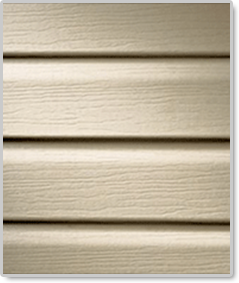Protecting and Cleaning Your Vinyl Siding

PROTECTING
Concentrated solar reflection from nearby energy-efficient glass windows, roofing, pavement, etc. can cause heat distortion to your vinyl siding. This can be prevented by blocking the path of this reflected sunlight with trees, shrubs, or fences (helpful accessory: window screens). Or in the case of reflections from nearby energy-efficient windows, these windows should have screens or awnings added to them.
Vinyl siding has a relatively low melting point, so you will want to be sure to keep heat sources (such as barbecue grills) and combustible materials (such as dry leaves, mulch, and trash) away from your vinyl siding. And when doing home projects that involve stains, sealants, and wet concrete, you should cover your vinyl siding to prevent these products from damaging your siding. Also, certain insecticides or herbicides can potentially stain your vinyl siding, and you should be carefully research and test in a small area before applying any of these products near your vinyl siding (helpful accessory: vinyl siding cleaners).
You should trim any shrubbery or trees which are near your house, so they don’t rub against and mar your vinyl siding. You should also inspect your siding to be sure that all areas are firmly attached, otherwise strong winds can use these loose areas to pull entire sections off of your home. Also inspect for areas which are damaged, cracked or punctured and need to be replaced to maintain water and pest protection for your home.
And be sure to consult with your vinyl siding manufacturer before painting vinyl siding. Many manufacturers void their warranties if their siding is painted. However, vinyl siding should never be painted a dark, heat-absorbing color, as it will cause your siding to tend to warp and sag when exposed to strong sunlight.
CLEANING
To keep your vinyl siding looking good, you should wash and clean it using a cleaner that is approved by your manufacturer. Small spots of mold and mildew can be removed with cleaners such as Fantastik or Windex. For larger sections, a solution of vinegar (30%) and water (70%) is usually effective, and is environmentally more friendly than using household cleaners and bleach. Do NOT use cleaners containing organic solvents, undiluted chlorine bleach, liquid grease remover, nail polish remover, or furniture polish or cleaners, as these can affect the surface of your vinyl siding.
Power washers should only be used if allowed by your particular manufacturer. If you do use a power washer, be careful not to etch the siding with too strong of a stream. And be sure to spray the water on a downward angle and away from any window edges or corners, so as to keep water from getting under your siding.
When washing and cleaning your vinyl siding, use a soft cloth or a long-handled soft-bristle brush (which works well for textured vinyl surfaces), and start at the bottom of your house and work up. If you go top to bottom, the cleaner and dirt that flows downwards can sit on the lower boards for too long and damage them. And be sure to thoroughly rinse the cleaning solution away completely before it dries.
Related Articles . . .
Properly Caring For Your Wood Siding
The biggest risk to wood siding is moisture, which will lead to rotting, insect infestations, mildew, mold, paint peeling, etc. This article covers tips for protecting, cleaning, power washing, repairing, and painting your home.
Taking Care of Your Brick Siding
Brick siding can give a home a stately appearance, and for most homes, brick siding requires significantly less maintenance than wood siding. However this does NOT mean NO maintenance.
Pest Control Advice from an Industry Insider
This article and video provides pest control advice from the owner of a pest and wildlife company, and describes keeping out pests, what to look for when hiring a professional, and what can go wrong.
Why You Need to Keep Rain Away From Your Foundation
Your home's gutters and downspouts play a very important role in protecting your home's foundation from water damage. This article explains why and how you should take care of your home's gutters and downspouts.
Is It Time to Replace My Roof?
Most asphalt roofs have a lifespan of 15-25 years, but this can vary significantly based on a variety of factors. So how can you tell if your roof needs to be replaced sooner, before damage to your home starts?









